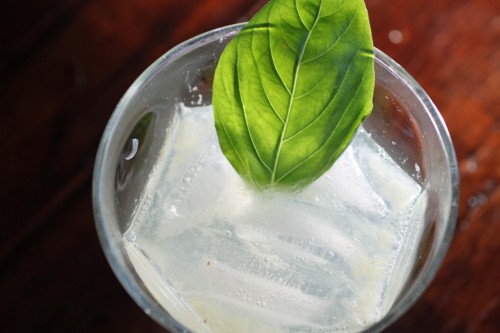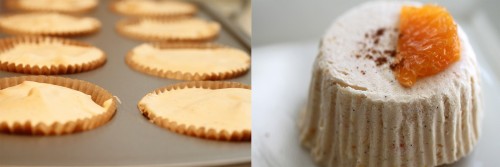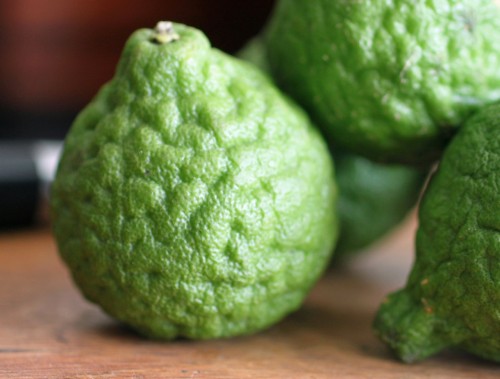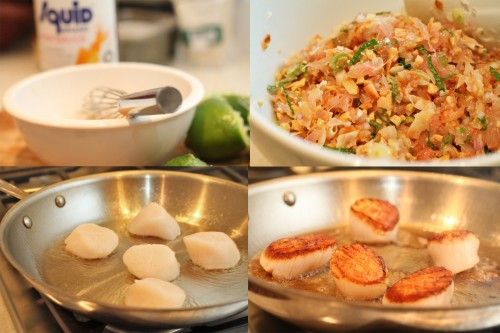Scallops with Thai Citrus Salad
It’s amazing the difference a year makes. I was actually in Thailand last winter and had the most beautiful pomelo salad, the inspiration for this recipe. A pomelo is a huge, grapefruit-like fruit that is found all over Southeast Asia. It’s sweet and lacks any of the bitterness typical of a grapefruit. Pomelos have a thick, spongy pith, and the fruit shreds into segments easily, which makes it perfect for a salad. When I got back, I had a hard time sourcing one, and then, lo and behold, a few weeks ago, I found them in Chelsea Market and on Fresh Direct! They are a beautiful fruit, so I’m so happy they are becoming more accessible.
When I was in Bangkok, I had the opportunity to spend the day at Face Bangkok, a cool, open-air restaurant compound with a swanky bar, a Thai restaurant, an Indian restaurant, and even a spa on site! The restaurant is part of a larger group that has branches in Jakarta, Beijing and Pudong, and is fantastic (if you happen to be visiting Bangkok) for a nice night out or drinks soaking up the chic scenery. I did a bit of intensive Thai cooking there, and this is my version of one dish that I learned.
This salad has a few different flavors and textures that I think work really well with a beautifully-caramelized, sweet scallop (as well as on its own!). If you can’t find a pomelo, delicious mandarins (satsumas are my fave) that are in season right now would work really well with all of the tangy and salty flavors. The peanuts and toasted coconut provide a great texture, a little umami from the fish sauce, sweetness and tartness from the tart lime juice – it’s light and refreshing and perfect to break up winter’s heavy dishes and take in some seasonal citrus. Enjoy!
Ingredients
Serves 4 as a main course or 6 for a starter
Salad:
¾ cup dried, unsweetened coconut (chips or shredded)
¾ cup peanuts, toasted and crushed
3 scallions, white and light green parts only, thinly sliced
½ shallot, finely minced
1 cup pomelo, segmented*
8-10 mint leaves, chiffonade
Citronette:
juice of 1 ½ limes
½ tsp salt
1 ½ tsps sugar
pinch of cayenne
1 ½ tsps fish sauce
1 ½ tbsps extra virgin olive oil
Scallops:
3 tbsps olive oil
2 lbs jumbo sea scallops
salt and freshly ground pepper to taste
1 tbsp butter
Procedure
In a skillet over medium heat, add the dried coconut and toast until the color is deep and golden. This process happens fairly quickly, so keep your eye on it. Add to a bowl along with the crushed peanuts, scallions, shallot and pomelo (and any juice that resulted from segmenting the pomelo).
For the dressing, combine the lime juice, sugar, salt and cayenne and whisk to dissolve thoroughly. Add the fish sauce and then slowly drizzle in the extra virgin olive oil whisking to combine. Toss salad with dressing, add mint, and season to taste.
For the scallops, you want to develop a nice deep color on them. Thoroughly dry the scallops before cooking and season generously with salt and pepper. If they are wet, they won’t caramelize and will sort of steam in the pan. Also, if you crowd the pan, they will also steam, so work in batches if necessary.
Heat a skillet over medium-high heat and add olive oil. When it’s just about to smoke, add the scallops, dragging a little so that the side gets coated in olive oil. Cook for about two minutes and add the butter. Let cook for another minute or so and then flip. They should have a nice brown crust on them. At this point, I turn the heat down just a tad. Let them cook on this side for another three minutes or so until they are cooked to your desired level. I like mine so that the middle third looks a bit translucent and the top and bottom thirds are opaque, but remember different-sized scallops will take differing cooking times. This is what I use to cook jumbo or U10-sized scallops.
Serve scallops hot with the cool salad spooned over top.
*The pomelo is a pretty unique fruit. To segment, I like to cut off as much of the rind and pith as possible. Then, I take out the larger, membrane-enclosed segments (much like a grapefruit or orange) and slip a pairing knife under the membrane. Once this is peeled away, the inner fruit shreds into little pieces. I like to do this over a bowl and catch all of the residual juice, which adds great flavor to the salad.

























